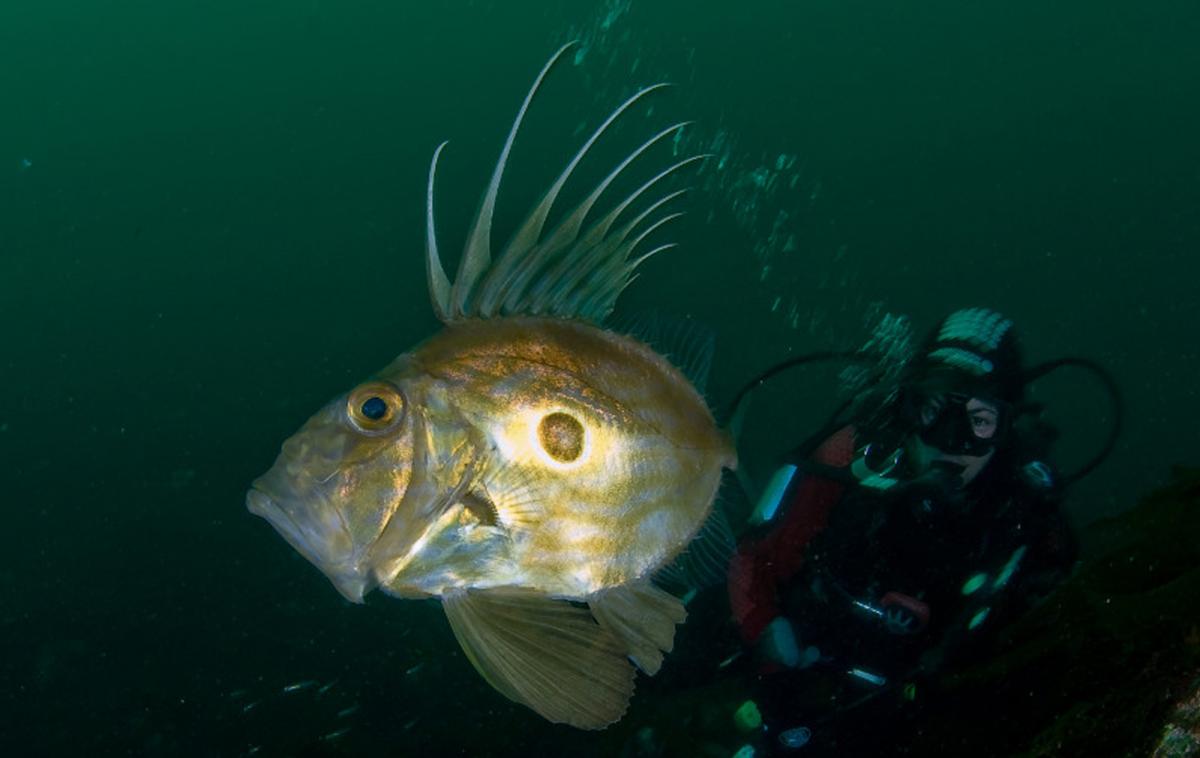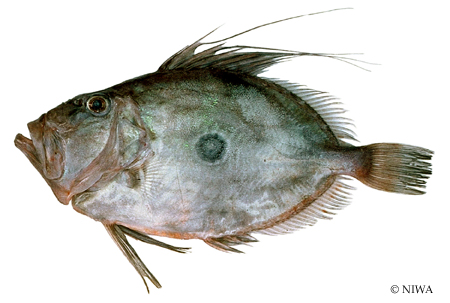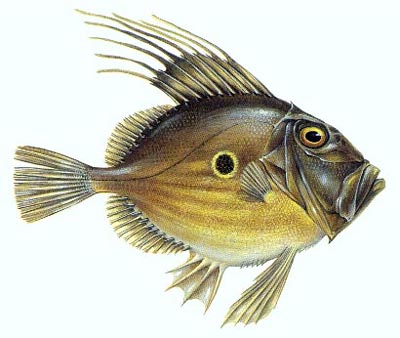
Zeus faber
FAMILY
Zeidae
TAXONOMY
Zeus faber Linnaeus, 1758, habitats in Pelago.
OTHER COMMON NAMES
French: Saint-Pierre; German: Heringskцnig; Spanish: Pez de
San Pedro, gallo de San Pedro, barbero, gallo barbero; Portuguese:
Peixe galo.
PHYSICAL CHARACTERISTICS
Attains a total length (including the tail fin) of 3 ft (90 cm) and
a weight of 18 lb (8.2 kg). The head and body are very compressed
and shaped like an oblong disc, or dinner platter. The
dorsal head profile is straight. The dorsal fin spines of the
adult are greatly elongated and filamentous. Scales are minute,
cycloid, and embedded; there are five to eight bony bucklers
(enlarged, platelike scales) along the base of the soft dorsal and
anal fins and seven to 10 pairs of spiny scutes along the belly
from the base of the pelvic fins to the anus. The dorsal fin has
nine to 11 spines and 22–24 rays, and the anal fin has four
spines and 20–23 rays. Dorsal, anal, and pectoral fin rays are
unbranched, and the caudal fin has 11 branched rays. The
pelvic fins are enlarged, situated below and slightly in front of
the pectoral fins, with one spine and six or seven branched
rays. The pectoral fins are much smaller than the pelvic fins.
The head and body are silvery to olive-brown, with a conspicuous
yellow or white-edged, blue-black ocellus on the middle
of the body below the lateral line. The body often has
indistinct dark, wavy stripes. The dorsal fin spine filaments are
white. Juveniles are small, about 1 in (2–3 cm) long. Color is
brownish, with small black spots along the base of the median
fins, curved white and black stripes on the head and body, and
the usual round black spot on the middle of the body below
the lateral line.
DISTRIBUTION
Eastern Atlantic from the North Sea to South Africa, including
the Mediterranean Sea, Black Sea, Azores, Madeira, and Ca-
nary and Cape Verde Islands and along the west coast of Africa
to Namibia. In the western Indian Ocean from South Africa to
Somalia and India. In the western Pacific in Indonesia, the
Philippines, China, Taiwan, Japan, Australia, and New
Zealand. Not known from the eastern Pacific or western Atlantic.
HABITAT
Adults are found over soft (sandy or muddy) or hard (rocky)
substrata; they are demersal, usually caught near the bottom of
the continental shelf or upper continental slope region at
depths of 33–1,188 ft (10–360 m). Adults also frequently occur
in midwater or near the surface.
BEHAVIOR
Adults usually are solitary, although they probably congregate
for spawning. They typically occur near the bottom, but they
often make excursions above the bottom to feed on midwater
fishes. With its greatly compressed head and body, large
mouth, and extremely protrusible upper jaw, the John Dory is
a successful ambush predator. It slowly approaches an unsuspecting
small fish by means of undulating waves of the transparent
soft dorsal and anal fins. In one quick motion it drops
the “trapdoor” lower jaw, shoots out the upper jaw, and expands
the gill cavity, sucking in the hapless prey along with a
considerable volume of water.
FEEDING ECOLOGY AND DIET
The John dory is a carnivore, feeding primarily on fishes, crustaceans,
and cephalopods. Prey species selection is influenced by
the availability and accessibility of prey. The dominant species
in the diet is likely to be the most abundant prey in the
HABITAT
.
In the North Atlantic, juveniles, 3–10 in (8–25 cm), feed mainly
on benthic fishes, for example, dragonets (
FAMILY
Callionymidae)
and Norway pout (
FAMILY
Gadidae). Adults, 10–22 in
(25–56 cm), switch to a diet of larger schooling fishes, primarily
blue whiting, Micromesistius poutassou (Risso, 1826), and
snipefish, Macroramphosus scolopax (Linnaeus, 1758), of the
FAMILY
Macroramphosidae. Adults have few predators, except for
great white sharks and goosefishes (Lophius spp.). Juveniles are
probably eaten by piscivorous predators.
REPRODUCTIVE BIOLOGY
The John dory is a broadcast spawner. The eggs and sperm are
shed simultaneously into the water, where fertilization takes
place. In the northeastern Atlantic, spawning occurs in April or
May. The eggs and larvae are pelagic; the eggs are small (0.1
in or 2 mm diameter) and spherical, with a large oil globule.
No nest building or parental care has been reported for the
species. In the North Atlantic, John dory males mature in their
second or third year at a length of about 10 in (26 cm), and
they may live to an age of 13 years. Females are three or four
years old when they become mature at a length of 14 in (35
cm). They grow larger than males do, and they may live 15
years. In New Zealand waters males attain maturity at 11.8 in
(30 cm) in two years; their growth then slows considerably,
with a maximum size of about 15.7 in (40 cm) and an age of
nine years. Females grow faster and attain a maximum size of
about 18.1 in (46 cm) and an age of nine years.
CONSERVATION STATUS
Not listed by IUCN. As of 1998 there were no regulations regarding
John dory fishery in the English Channel or in Australian
waters. The species is taken as bycatch in the trawl
fisheries of the eastern Atlantic, South Africa, Australia, New
Zealand, Indonesia, Philippines, Taiwan, and Japan.
SIGNIFICANCE TO HUMANS
The John dory is prized as a food fish and is of commercial
importance because of its high price in fish markets.
Photo Gallery of - John dory





 Animalia Life
Animalia Life